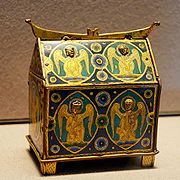
Almery
Encyclopedia

Architecture
Architecture is both the process and product of planning, designing and construction. Architectural works, in the material form of buildings, are often perceived as cultural and political symbols and as works of art...
, is a recess in the wall of a church, sometimes square-headed, and sometimes arched over, and closed with a door like a cupboard. It is sometimes a cabinet attached to the wall.

Roman Catholic Church
The Catholic Church, also known as the Roman Catholic Church, is the world's largest Christian church, with over a billion members. Led by the Pope, it defines its mission as spreading the gospel of Jesus Christ, administering the sacraments and exercising charity...
usage, when commonly called an ambry, it is traditionally located in the sanctuary
Sanctuary
A sanctuary is any place of safety. They may be categorized into human and non-human .- Religious sanctuary :A religious sanctuary can be a sacred place , or a consecrated area of a church or temple around its tabernacle or altar.- Sanctuary as a sacred place :#Sanctuary as a sacred place:#:In...
(as in, the altar
Altar
An altar is any structure upon which offerings such as sacrifices are made for religious purposes. Altars are usually found at shrines, and they can be located in temples, churches and other places of worship...
area) of a church or in the Baptistery
Baptistery
In Christian architecture the baptistry or baptistery is the separate centrally-planned structure surrounding the baptismal font. The baptistry may be incorporated within the body of a church or cathedral and be provided with an altar as a chapel...
, and is used for the storage of the oils used in sacraments: Oil of catechumens
Oil of catechumens
Oil of the Catechumens is the oil used in some traditional Christian churches during baptism; it is believed to strengthen the one being baptized to turn away from evil, temptation and sin....
(indicated by the Latin letters O.C.), Oil of the Sick
Anointing of the Sick
Anointing of the Sick, known also by other names, is distinguished from other forms of religious anointing or "unction" in that it is intended, as its name indicates, for the benefit of a sick person...
(O.I.), and Sacred Chrism
Chrism
Chrism , also called "Myrrh" , Holy anointing oil, or "Consecrated Oil", is a consecrated oil used in the Roman Catholic, Eastern Orthodox, Eastern Rite Catholic, Oriental Orthodox, in the Assyrian Church of the East, and in Old-Catholic churches, as well as Anglican churches in the administration...
(S.C.). Former regulations required it to be secured and locked, and lined and veiled with either purple cloth (in reference to the Oil of the Sick) or white (for the Sacred Chrism). The door was usually marked "O.S." or Olea Sancta, to indicate the contents. Such regulations are now relaxed so that while many churches continue to use such an ambry, the oils are also stored and in some cases displayed in other ways.
The term can also be used less formally to indicate a cabinet that contains the chalice
Chalice (cup)
A chalice is a goblet or footed cup intended to hold a drink. In general religious terms, it is intended for drinking during a ceremony.-Christian:...
s, basins, cruets, etc., for the use of the priest; many of them have stone shelves. They are sometimes near the piscina
Piscina
A piscina is a shallow basin placed near the altar of a church, used for washing the communion vessels. The sacrarium is the drain itself. Anglicans usually refer to the basin, calling it a piscina. Roman Catholics usually refer to the drain, and by extension, the basin, as the sacrarium...
, but more often on the opposite side. The word also seems in medieval times to be used commonly for any closed cupboard and even bookcase. (See also aumbry
Aumbry
In the Middle Ages an aumbry was a cabinet in the wall of a Christian church or in the sacristy which was used to store chalices and other vessels, as well as for the reserved sacrament, the consecrated elements from the Eucharist. This latter use was infrequent in pre-Reformation churches,...
).

